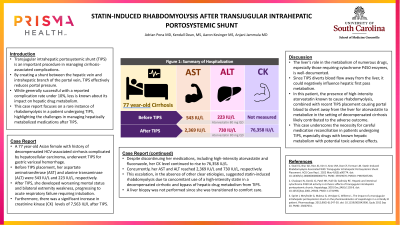Sunday Poster Session
Category: Liver
P1395 - Statin-Induced Rhabdomyolysis After TIPS
Sunday, October 27, 2024
3:30 PM - 7:00 PM ET
Location: Exhibit Hall E

Has Audio

Adrian Pona, MD
Prisma Health, University of South Carolina School of Medicine
Greenville, SC
Presenting Author(s)
Adrian Pona, MD1, Aaron Kesinger, 2, Kendall Dean, 2, Pranav Patel, DO3, Anjani Jammula, MD4
1Prisma Health, University of South Carolina School of Medicine, Greenville, SC; 2University of South Carolina School of Medicine, Greenville, SC; 3Prisma Health Greenville Memorial Hospital, Greenville, SC; 4Prisma Health, Greenville, SC
Introduction: Transjugular intrahepatic portosystemic shunt (TIPS) is an important procedure in managing cirrhosis-associated complications. By creating a shunt between the hepatic vein and intrahepatic branch of the portal vein, TIPS effectively reduces portal pressure. While generally successful with a reported complication rate under 10%, less is known about its impact on hepatic drug metabolism. This case report focuses on a rare instance of rhabdomyolysis in a patient undergoing TIPS, highlighting the challenges in managing hepatically metabolized medications after TIPS.
Case Description/Methods: A 77 year-old Asian female with a history of decompensated hepatitis C-associated cirrhosis complicated by hepatocellular carcinoma, underwent TIPS for gastric variceal hemorrhage. Before TIPS placement, her aspartate aminotransferase (AST) and alanine transaminase (ALT) were 543 IU/L and 223 IU/L, respectively. After TIPS, she developed worsening altered mental status and bilateral extremity weakness, progressing to acute respiratory failure requiring intubation. Furthermore, there was a significant increase in creatinine kinase levels of 7,563 IU/L after TIPS. Despite the discontinuation of her medications, including high-intensity atorvastatin and fluconazole, her creatinine kinase level continued to rise to 76,358 IU/L. Concurrently, her AST and ALT reached 2,369 IU/L and 730 IU/L, respectively. This escalation, in the absence of other clear etiologies, suggested statin-induced rhabdomyolysis due to concomitant use of a high-intensity statin in a decompensated cirrhotic and bypass of hepatic drug metabolism from TIPS. A liver biopsy was not performed since she was transitioned to comfort care.
Discussion: The liver's role in the metabolism of numerous drugs, especially those requiring cytochrome P450 enzymes, is well-documented. Since TIPS diverts blood flow away from the liver, it could negatively influence hepatic first pass metabolism. In this patient, the presence of high-intensity atorvastatin known to cause rhabdomyolysis, combined with recent TIPS placement causing portal blood to divert away from the liver for atorvastatin to metabolize in the setting of decompensated cirrhosis likely contributed to the adverse outcome. This case underscores the necessity for careful medication reconciliation in patients undergoing TIPS, especially drugs with known hepatic metabolism with potential toxic adverse effects.
Disclosures:
Adrian Pona, MD1, Aaron Kesinger, 2, Kendall Dean, 2, Pranav Patel, DO3, Anjani Jammula, MD4. P1395 - Statin-Induced Rhabdomyolysis After TIPS, ACG 2024 Annual Scientific Meeting Abstracts. Philadelphia, PA: American College of Gastroenterology.
1Prisma Health, University of South Carolina School of Medicine, Greenville, SC; 2University of South Carolina School of Medicine, Greenville, SC; 3Prisma Health Greenville Memorial Hospital, Greenville, SC; 4Prisma Health, Greenville, SC
Introduction: Transjugular intrahepatic portosystemic shunt (TIPS) is an important procedure in managing cirrhosis-associated complications. By creating a shunt between the hepatic vein and intrahepatic branch of the portal vein, TIPS effectively reduces portal pressure. While generally successful with a reported complication rate under 10%, less is known about its impact on hepatic drug metabolism. This case report focuses on a rare instance of rhabdomyolysis in a patient undergoing TIPS, highlighting the challenges in managing hepatically metabolized medications after TIPS.
Case Description/Methods: A 77 year-old Asian female with a history of decompensated hepatitis C-associated cirrhosis complicated by hepatocellular carcinoma, underwent TIPS for gastric variceal hemorrhage. Before TIPS placement, her aspartate aminotransferase (AST) and alanine transaminase (ALT) were 543 IU/L and 223 IU/L, respectively. After TIPS, she developed worsening altered mental status and bilateral extremity weakness, progressing to acute respiratory failure requiring intubation. Furthermore, there was a significant increase in creatinine kinase levels of 7,563 IU/L after TIPS. Despite the discontinuation of her medications, including high-intensity atorvastatin and fluconazole, her creatinine kinase level continued to rise to 76,358 IU/L. Concurrently, her AST and ALT reached 2,369 IU/L and 730 IU/L, respectively. This escalation, in the absence of other clear etiologies, suggested statin-induced rhabdomyolysis due to concomitant use of a high-intensity statin in a decompensated cirrhotic and bypass of hepatic drug metabolism from TIPS. A liver biopsy was not performed since she was transitioned to comfort care.
Discussion: The liver's role in the metabolism of numerous drugs, especially those requiring cytochrome P450 enzymes, is well-documented. Since TIPS diverts blood flow away from the liver, it could negatively influence hepatic first pass metabolism. In this patient, the presence of high-intensity atorvastatin known to cause rhabdomyolysis, combined with recent TIPS placement causing portal blood to divert away from the liver for atorvastatin to metabolize in the setting of decompensated cirrhosis likely contributed to the adverse outcome. This case underscores the necessity for careful medication reconciliation in patients undergoing TIPS, especially drugs with known hepatic metabolism with potential toxic adverse effects.
Disclosures:
Adrian Pona indicated no relevant financial relationships.
Aaron Kesinger indicated no relevant financial relationships.
Kendall Dean indicated no relevant financial relationships.
Pranav Patel indicated no relevant financial relationships.
Anjani Jammula indicated no relevant financial relationships.
Adrian Pona, MD1, Aaron Kesinger, 2, Kendall Dean, 2, Pranav Patel, DO3, Anjani Jammula, MD4. P1395 - Statin-Induced Rhabdomyolysis After TIPS, ACG 2024 Annual Scientific Meeting Abstracts. Philadelphia, PA: American College of Gastroenterology.
